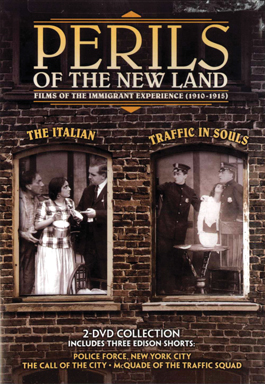home | metro silicon valley index | movies | current reviews | dvd review

Perils of the New Land: Films of the Immigrant Experience
(1920–1915)
Two discs; Flicker Alley; $39.95
Reviewed by Michael S. Gant
In the years leading up to World War I, migration—to the United States, and from the countryside to the nation's large cities—was a major social phenomenon. The cheap, easily available new entertainment, the silent film, benefited from large new audiences, and early moviemakers often tackled issues of class morality and mobility. Perils of the New Land, a two-disc set, offers excellent restored prints of two important films from the era: 1913's Traffic in Souls and 1915's The Italian. The former examines the hysteria that surrounded the issue of prostitution and "white slavery." As noted by author Shelley Stamp on the better-than-average audio commentary, the period saw a spate of films deploring—and reveling in—the supposed epidemic of enforced prostitution (Traffic in Souls claims with a straight face that 50,000 young women are abducted annually.) They expressed society's unease with the idea of women leaving the home and entering the workplace, hence the emphasis on the perils of such a shift from the domestic to the public sphere. A fairly sophisticated drama, Traffic in Souls follows the plight of a cake-shop girl kidnapped to work in a "den of iniquity" and the efforts of her sister to save her; this story line is contrasted with the machinations of the rich man who controls the vice underworld while hiding his activities behind a facade of civic concern for virtue. As is often the case in early silents from a modern perspective, the best parts are the location shots of New York street cars and docks—one scene shows a boat full of immigrants arriving, and has the authenticity of a documentary. Also fascinating is the surprisingly advanced technology: the bad guys use a dictograph and electronic writing pad to communicate between offices, and the heroine nails them at their own game by installing a wiretap in the office (no warrant required!). The film winds up to a big conclusion with a rooftop chase and shootout that filmmakers have been copying ever since, followed by a remarkably advanced fluid tracking shot of the villains in lockup. The Italian showcases George Beban, a famous actor of the time who specialized in ethnic roles. As Beppo, a dreamy Venetian gondolier, Beban is actually restrained, considering the exaggerated stereotypes of the period. The early scenes in Italy are postcard bucolic (and actually filmed in Santa Ynez). Beppo immigrates to the United States in order to earn enough money to send for his true love, Annette. Life in the slums proves to be hard, and Beppo falls afoul of the law, leading to tragedy. Some judicious tinting enhances the Italian scenes, and several times we are treated to that most startling of early-cinema shots: the desperate man advancing straight toward the camera, looming at the viewer with overwhelming force. The film evinces a considerable amount of sympathy for the plight of the immigrant—a sentiment that would put today's political debate to shame. The set comes with two early Edison shorts and a booklet featuring the original ad art for the films.
Click Here to Talk About Movies at Metro's New Blog
Send a letter to the editor about this story.
|
|
|
|
|
|